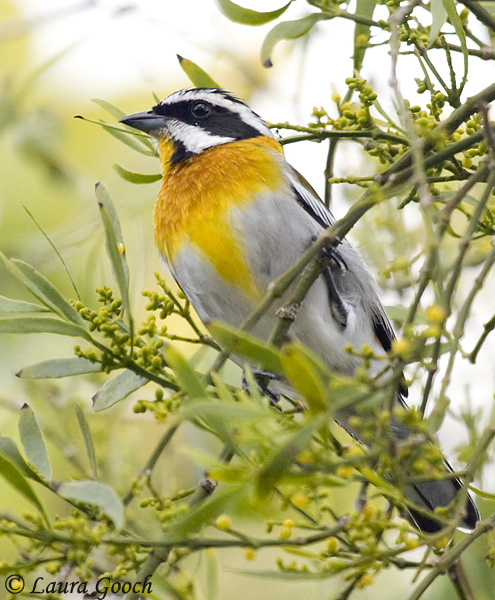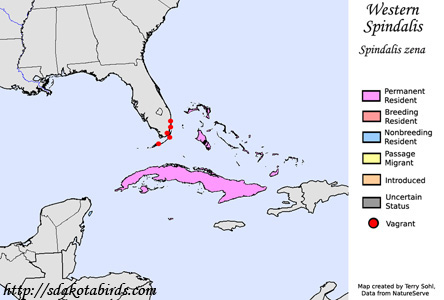| Length: 6.75 inches | Wingspan: 9.5 inches | Seasonality: Non-resident in South Dakota |
| ID Keys: Bold black and white pattern on face and wings, orange breast, neck, and rump, light flanks and undertail | ||
 The
Western Spindalis is widespread in the Caribbean, but in the U.S. is just a
rare visitor to southern Florida. There, most records have been in the
winter, mostly lone birds. However, there have been sightings of small
groups of birds in Florida in the spring, and in 2009, a nest with 3 young
was found in the Everglades National Park, the first confirmed breeding in
the United States. Taxonomy of the species has been debated, and there
is some question as to its status in the "Tanager" family Thraupidae.
The
Western Spindalis is widespread in the Caribbean, but in the U.S. is just a
rare visitor to southern Florida. There, most records have been in the
winter, mostly lone birds. However, there have been sightings of small
groups of birds in Florida in the spring, and in 2009, a nest with 3 young
was found in the Everglades National Park, the first confirmed breeding in
the United States. Taxonomy of the species has been debated, and there
is some question as to its status in the "Tanager" family Thraupidae.
Habitat: In the Caribbean, found in tropical forests, dense forest undergrowth, and shrubby areas. Sightings in Florida have typically been in shrubby woodlands or in suburban areas with flowering and fruiting plants.
Diet: Feeds on both plant material and insects. Diet includes many fruits and berries, nectar, flowers, seeds, and insects.
Behavior: Often found in small mixed species flocks when seen outside of the breeding season, with small groups of birds visiting areas with fruiting trees and shrubs.
Nesting: The nest is a small cup built of grasses, weed stems, and other vegetative material. The female lays 2 to 4 eggs, The female alone incubates the eggs, but both the male and female help to feed the young upon hatching.
Song: Series of high-pitched, tinny notes ending with a buzzing series of notes.
Migration: Considered a permanent resident throughout their range. Some movement obviously occurs however, as most sightings in the U.S. have been during the winter months.
Interactive eBird map: Click here to access an interactive eBird map of Western Spindalis sightings
Similar Species: Distinctive if seen well.
Feeders: Will sometimes come to fruit feeders for offered apple halves. The species can be attracted to yards with many fruiting and flowering trees and shrubs.
Conservation Status: Populations appear to be stable, and the IUCN lists the Western Spindalis as a species of "Least Concern".
Further Information: 1) South Florida Birding - Western Spindalis
2) WhatBird - Western Spindalis
3) AvianWeb.com - Western Spindalis
Photo Information: Photo taken by Laura Gooch - Photo licensed under Creative Commons Attribution Noncommercial ShareAlike 2.0 Generic License
| Click below for a higher-resolution map |
 |
| South Dakota Status: Non-resident in South Dakota |
Additional Western Spindalis Photos (coming soon!!)
